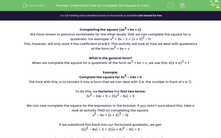Completing the square (ax2 + bx + c)
We have shown in previous worksheets for the other levels, that we can complete the square for a quadratic. For example: x2 + 6x – 2 = (x + 3)2 - 11
This, however, will only work if the coefficient of x is 1. This activity will look at how we deal with quadratics of the form ax2 + bx + c
What is the general form?
When we complete the square for a quadratic of the form ax2 + bx + c, we use this: d(x ± e)2 ± f
Example:
Complete the square for 3x2 – 24x + 5
The trick with this, is to convert it into a form that we can deal with (i.e. the number in front of x is 1).
To do this, we factorise the first two terms:
3x2 – 24x + 5 = 3{x2 – 8x} + 5
We can now complete the square for the expression in the bracket. If you aren’t sure about this, take a look at activity 7942 on completing the square.
x2 – 8x = (x + 4)2 – 16
If we substitute this back into our factorised quadratic, we get:
3{x2 – 8x} + 5 = 3{(x + 4)2 – 16} + 5
Our penultimate step is to multiply by the 3 we factorised out earlier:
3{(x + 4)2 – 16} + 5 = 3(x + 4)2 – 48 + 5
And the final step is to collect the like terms:
3(x + 4)2 – 48 + 5 = 3(x + 4)2 – 43
There's lots to remember here, so have another look through the example before attempting the questions.







